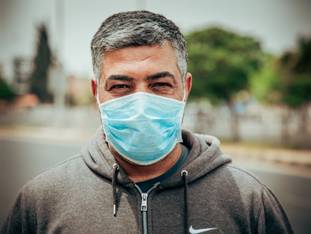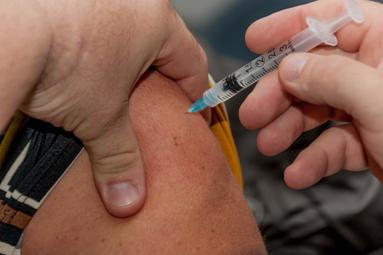Masks Don’t Impact Oxygen or Carbon Dioxide Levels
 Though the rollout of a vaccine has begun, health experts are still in agreement that wearing a mask remains the best protection from COVID-19 exposure. That is especially true for those suffering from chronic obstructive pulmonary disease (COPD), which is one of the underlying conditions that can increase the severity of a COVID-19 infection.
Though the rollout of a vaccine has begun, health experts are still in agreement that wearing a mask remains the best protection from COVID-19 exposure. That is especially true for those suffering from chronic obstructive pulmonary disease (COPD), which is one of the underlying conditions that can increase the severity of a COVID-19 infection.
While some people with breathing and lung ailments are concerned about masks impacting their levels of oxygen and carbon dioxide, recent research proves otherwise. According to a study in the Annals of the American Thoracic Society that included 15 veterans suffering from COPD, wearing a mask has a negligible effect on oxygen and carbon dioxide levels.
Each participant in the study completed a six-minute walk while wearing a surgical face mask. Arterial blood analysis was performed before and immediately after the walk. Participants, while resting and wearing a mask, then had their blood-oxygen levels checked at five and 30 minutes. The result was there was no significant change in end-tidal carbon dioxide or oxygen saturation at rest.
Subjects with severe COPD experienced decreased oxygenation as expected during the six-minute masked walk — but they didn’t exhibit any major changes in gas exchange, especially in carbon dioxide retention.
Dr. Michal Campos, the study’s lead author, said the results show that wearing a mask has little to no effect on gas exchange. If anyone wearing a mask is feeling a shortness of breath, it is likely occurring from the restriction of air flow with the mask, Campos said, and not from an increase of carbon dioxide. That can be fixed by wearing a mask with better ventilation.
These findings are not a surprise to Louis Irving, the Director of Respiratory and Sleep Medicine at the Royal Melbourne Hospital.
“The reality is that patients with COPD, particularly if they’ve got bad COPD, do find it more uncomfortable to wear a mask and that will be unrelated to oxygen and carbon dioxide levels,” he said.
Read the complete story in newsGPfor more on the study.
Flu Shot May Be a COPD Lifesaver
 The flu vaccine may sincerely be a lifesaver for patients with chronic obstructive pulmonary disease (COPD). When struck with the flu, A bout of the flu may not only prompt COPD flare-ups—a leading cause of hospital admissions and readmissions—but can lead to life-threatening complications.
The flu vaccine may sincerely be a lifesaver for patients with chronic obstructive pulmonary disease (COPD). When struck with the flu, A bout of the flu may not only prompt COPD flare-ups—a leading cause of hospital admissions and readmissions—but can lead to life-threatening complications.
Seasonal flu shots are recommended for the general public, especially individuals over 65, but most important as a health precaution for anyone diagnosed with a respiratory condition, including COPD. According to estimates, only about 50% of patients with COPD are vaccinated.
Per a 2019 study published in CHEST, study data from 46 hospitals that were collated from part of the Canadian Immunization Research Network (CIRN) Serious Outcomes Surveillance (SOS) Network from 4,755 hospitalized patients with COPD. Of these, 4,198 (88.3%) had known vaccination status.
The study found a 38% reduction in influenza-related hospitalizations in vaccinated vs. unvaccinated patients, and also suggested that those individuals with COPD are at a higher risk of dying if hospitalized with the flu, compared to the general population.
The study found that 34% of the hospitalized patients with COPD were not vaccinated in the season during which they were hospitalized. The study also noted that antiviral medication use in the hospital can help reduce flu-associated complications, even though doctors may be reluctant to prescribe it 48 hours after the onset of symptoms.
Flu vaccines have the potential to reduce flu-related hospitalizations and improve the outcome of illness in patients with COPD.
7 Tips for Protecting Your Lungs in the Frigid Temperatures
 Periods of extreme cold can present numerous dangers for individuals with lung disease as these conditions can cause difficulty with breathing. Although many patients choose to remain inside when temperatures drop to frigid temperatures, they must eventually brave the cold. During these times, individuals with lung disease should attempt to adhere to the following preventative measures:
Periods of extreme cold can present numerous dangers for individuals with lung disease as these conditions can cause difficulty with breathing. Although many patients choose to remain inside when temperatures drop to frigid temperatures, they must eventually brave the cold. During these times, individuals with lung disease should attempt to adhere to the following preventative measures:
1. Protect Oxygen Tubing from the Elements
When preparing to go outside during these extreme temperatures, oxygen tubing should be zipped inside an individual’s clothing. If the tubing is exposed to the cold, there is a risk that the cannula and oxygen tubing will quickly stiffen, which could reduce the flow of oxygen.
2. Pre-Heat Vehicles
If possible, vehicles should be pre-heated before sitting in one. The warmth of a vehicle will provide “a quick reprieve” for lungs following exposure to cold air and will also help the body warm up quickly.
3. Keep a Scarf Over Nose and Mouth
As long as a scarf is not wrapped too tight, it helps patients “to lock in the warm air” that they exhale. Although this can be a helpful technique, it is important to only use it for short periods of time in frigid temperatures.
4. Avoid Solely Carrying/Transporting Items
Breathing when exposed to extreme cold is already difficult for people with healthy lungs. This experience is amplified for those with lung disease. When possible, patients should request assistance from others to help carry and transport items including their oxygen tanks.
5. Drink a Glass of Warm Water When Returning Indoors
Many patients find it helpful to drink warm water to alleviate the “burning sensation of the lungs after exposure to the cold.” It’s key to note that the water should not be hot, but instead lukewarm or room temperature.
6. Park Vehicles in a Garage
Parking in a garage can be helpful for patients as they can avoid having to remove snow off a vehicle or scrape ice from a windshield. In turn, patients experience less exposure to the cold and can avoid excess exertion while outside.
7. Use Rescue Puffers Liberally
Many patients continue to “use various types of puffers, such as inhaled steroids, rescue inhalers or maintenance medication.” These products should be readily available for use at all times, especially during periods of extreme cold.
Click Here to Access the Full Article on Lung Disease News
Some Children with Asthma May Need Different Treatment Approach
A recent study suggests that certain children with asthma, “may require a different treatment approach.” The study was led by Henry Ford Health System along with eight other U.S. health systems.
Henry Ford is one of the nine health care systems that encompass the Inner City Asthma Consortium, which is dedicated to determine severe asthma prevention and reduction methods among inner city children.
 Researchers analyzed data from 717 children through the ages of six to 17 for a span of one year. Five groups of children with asthma were identified through the utilization of a computer “clustering program, based on the characteristics of the disease. Each group was categorized by, “asthma severity, presence of allergy, associated nasal symptoms and lung function test abnormalities.”
Researchers analyzed data from 717 children through the ages of six to 17 for a span of one year. Five groups of children with asthma were identified through the utilization of a computer “clustering program, based on the characteristics of the disease. Each group was categorized by, “asthma severity, presence of allergy, associated nasal symptoms and lung function test abnormalities.”
Researchers discovered that although these patients were suffering from fewer allergies and receiving high levels of preventative medication, they were continuing to frequently experience asthma symptoms. This differed from four other tested groups that found a correlation between increasingly difficult asthma and an increase in allergies.
The study’s lead author and division head of Allergy and Immunology at Henry Ford, Edward Zoratti, claims that the study reveals that the current guidelines to manage asthma are not as effective for, “this particular group of young asthma sufferers.”
Zoratti believes that additional research is required to, “determine appropriate interventions tailored to this group of children.” He also believes that this research may indicate a lack of knowledge in regards to asthma, “among children experiencing a particular type of the disease."
Click Here to Access the Full Article on News Medical Life Sciences
How Your Everyday Diet Affects Your Fight Against COPD
 It is well-known that the food we eat affects our health, but did you know that it can also affect the way we fight diseases? Lung diseases, such as chronic obstructive pulmonary disease (COPD) often are treated with medications, inhalers, and supplemented oxygen, but diet has recently come to the forefront as a factor in the way the body deals with the symptoms of COPD.
It is well-known that the food we eat affects our health, but did you know that it can also affect the way we fight diseases? Lung diseases, such as chronic obstructive pulmonary disease (COPD) often are treated with medications, inhalers, and supplemented oxygen, but diet has recently come to the forefront as a factor in the way the body deals with the symptoms of COPD.
In new research published in Annals of American Thoracic Society, study researchers found that “people who ate the most fiber fared better in lung capacity tests.” They were able to determine this using data from 1,921 adults, ages 40 to 79, who participated in a large national database compiled by the Centers for Disease Control and Prevention. By pulling their diet and nurtrition information, researchers were able to determine that “68.3 percent of the fiber eaters had normal lung function compared to 50.1 percent of those who did not eat a lot of fiber. In addition, just 14.8 percent of those with fiber-rich diets had airway restriction, compared to 29.8 percent of those who did not follow such diets.”
It was also noted that those participants with the “highest fiber intake also had greater lung capacity and could exhale more air in one second, which are also important indicators of lung health,” but the way diet affects lung health doesn’t stop at fiber.
Another study was also recently conducted that illustrated the impact that omega-3 fatty acids have on the symptoms of COPD. A compound derived from fatty acids, like fish oil, “showed promise for preventing a bacterial respiratory infection that is a common cause of disease exacerbation.” This means that future treatments may be able to be derived from these compounds in order to prevent bacterial infection and symptom exacerbation in those patients dealing with COPD.




